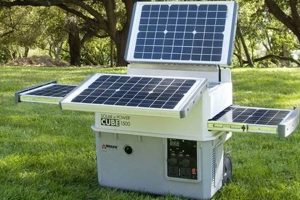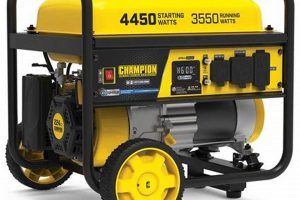Compact, fuel-powered devices capable of generating electricity independently of the main power grid offer a crucial backup power source during blackouts, storms, or other grid disruptions. These units can power essential household appliances, electronics, and tools, maintaining a degree of normalcy and safety during emergencies. For example, a typical unit might power refrigerators, lights, and sump pumps during an extended power outage.
Access to backup power provides continuity for critical services and enhances safety during unforeseen events. Historically, relying solely on the grid meant vulnerability to disruptions. These independent power sources minimize that vulnerability, allowing continued operation of life-sustaining equipment like medical devices or heating systems. This resilience offers peace of mind and significantly mitigates the risks associated with power loss.
This exploration will delve into various aspects of these emergency power solutions, including selecting the right unit size, understanding different fuel types and their respective advantages, essential safety precautions during operation, proper maintenance procedures, and exploring potential future trends in backup power technology.
Essential Tips for Utilizing Backup Power
Careful planning and operation are crucial for maximizing the effectiveness and safety of independent power sources during outages.
Tip 1: Accurate Power Needs Assessment: Calculate the wattage requirements of essential appliances and devices to select a unit with sufficient capacity. Overloading a generator can lead to damage and safety hazards. Prioritize essential loads and avoid powering non-essential items during an outage.
Tip 2: Proper Generator Placement: Operate generators outdoors in well-ventilated areas, away from windows and doors, to prevent carbon monoxide poisoning. Ensure the unit is on a stable, level surface and protected from rain and snow.
Tip 3: Safe Fuel Handling: Allow the generator to cool completely before refueling. Store fuel in approved containers in a well-ventilated area away from ignition sources. Never refuel a running generator.
Tip 4: Regular Maintenance: Perform routine maintenance according to the manufacturer’s recommendations, including oil changes, air filter cleaning, and spark plug replacement. This ensures reliable operation during emergencies.
Tip 5: Connection and Disconnection Procedures: Use a properly rated transfer switch to safely connect the generator to the home’s electrical system. Never connect a generator directly to a wall outlet, as this can create a dangerous backfeed to the power grid.
Tip 6: Carbon Monoxide Detectors: Install and maintain working carbon monoxide detectors in the home. Carbon monoxide is a colorless, odorless gas that can be fatal. These detectors provide an early warning of dangerous levels.
Adhering to these guidelines ensures safe and efficient operation, maximizing the benefits of backup power during outages and minimizing potential risks.
By understanding and implementing these strategies, households can be well-prepared to navigate power disruptions safely and effectively, maintaining essential services and enhancing overall resilience.
1. Power Output
Generator power output, measured in watts, is a critical factor determining its suitability for specific applications during power outages. Selecting a generator with insufficient output can lead to overloaded circuits and potential damage, while an excessively large unit represents unnecessary expense and fuel consumption. Understanding power output is therefore fundamental to choosing the correct generator for individual needs.
- Running Watts vs. Starting Watts
Running watts refer to the continuous power a generator can supply, while starting watts represent the surge of power required to start motor-driven appliances like refrigerators or air conditioners. Starting watts typically exceed running watts. For example, a refrigerator might require 1,000 starting watts but only 200 running watts. Accurately assessing both values is crucial for preventing overloads.
- Calculating Power Requirements
Determining the necessary generator size involves calculating the combined wattage of all intended appliances. This involves checking appliance labels for wattage information and adding those values together. Online calculators and resources can assist with this process. Prioritizing essential appliances during an outage helps refine the required power output, potentially reducing generator size and cost.
- Matching Power Output to Needs
Different power outage scenarios necessitate different generator sizes. A small generator might suffice for powering essential lights and communication devices, while larger units can support critical medical equipment or power entire homes. Matching power output to specific needs ensures reliable backup power without overspending or risking overloads.
- Power Output and Fuel Consumption
Higher power output generally translates to higher fuel consumption. Choosing a generator with appropriate power output, rather than an excessively large unit, can minimize fuel costs and environmental impact. Fuel efficiency is an important consideration for extended power outages.
Matching generator power output to specific requirements is essential for safe and efficient operation during power outages. Careful consideration of running watts, starting watts, and overall power needs ensures optimal performance and prevents potential damage from overloads. This selection process, informed by an understanding of power output, directly contributes to the effectiveness and value of a backup power solution.
2. Fuel Type
Fuel type significantly influences the practicality and effectiveness of portable generators during power outages. Various fuel options exist, each presenting distinct advantages and disadvantages regarding availability, cost, storage, and environmental impact. Understanding these trade-offs is crucial for selecting a generator suitable for specific needs and circumstances. For example, gasoline offers widespread availability but requires careful storage due to flammability and deteriorates over time. Propane, while requiring larger storage tanks, offers a longer shelf life and cleaner combustion.
Common fuel types include gasoline, propane, diesel, and natural gas. Gasoline generators are often more readily available and less expensive initially, but gasoline fuel has a shorter shelf life. Propane burns cleaner and can be stored indefinitely, but requires a larger, more specialized tank. Diesel offers excellent fuel efficiency and long run times, ideal for extended outages, but diesel generators tend to be more expensive and heavier. Natural gas generators offer convenience for those with existing natural gas lines at their homes, eliminating the need for refueling, but they require professional installation and lack portability. The choice of fuel type should reflect the anticipated duration and frequency of power outages, as well as fuel availability and storage considerations. A rural location might prioritize propane or diesel due to potential gasoline shortages, while an urban environment with readily available gasoline might prioritize gasoline generators.
Choosing the right fuel type involves balancing cost, convenience, and long-term practicality. Careful consideration of fuel availability during emergencies, storage requirements, and environmental impact is paramount. Understanding the characteristics of each fuel type directly impacts the efficacy and reliability of a portable generator during a power outage. The decision represents a crucial step in emergency preparedness planning.
3. Runtime
Runtime, representing the duration a portable generator can operate continuously on a single fuel tank, is a critical consideration for power outage preparedness. Selecting a generator with insufficient runtime can leave essential systems without power during extended outages. Conversely, excessive runtime capacity may represent unnecessary fuel consumption and cost. Understanding the factors influencing runtime and matching it to anticipated outage durations is essential for effective backup power planning.
- Fuel Tank Capacity
Larger fuel tanks directly translate to longer runtimes, assuming consistent power output. A higher fuel capacity minimizes refueling frequency during extended outages, enhancing convenience and reducing disruption. However, larger tanks increase the generator’s size and weight, potentially impacting portability. The optimal tank size balances runtime needs with practical considerations.
- Load and Power Output
The power demands placed on a generator significantly influence its runtime. Higher power output and heavier loads consume fuel more rapidly, reducing the overall runtime. Operating the generator at a lower output, by powering only essential devices, extends its operational duration. Accurately assessing power needs and selecting a generator with sufficient capacity is crucial for maximizing runtime.
- Engine Efficiency
Engine efficiency plays a key role in determining how effectively a generator converts fuel into usable power. More efficient engines consume less fuel for the same power output, extending runtime. Technological advancements continue to improve engine efficiency, offering longer runtimes with smaller fuel tanks. Choosing a generator with a fuel-efficient engine optimizes runtime and minimizes fuel costs.
- Fuel Type
Different fuel types offer varying energy densities, influencing runtime. For instance, diesel generally provides longer runtimes compared to gasoline for the same tank size due to its higher energy density. The choice of fuel type, alongside tank capacity, impacts the overall operational duration of the generator. Considering fuel availability during outages is another critical factor in fuel type selection.
Optimizing runtime requires careful consideration of fuel tank capacity, load management, engine efficiency, and fuel type. Matching the anticipated outage duration to the generator’s runtime ensures uninterrupted power for essential devices. A thorough understanding of these interconnected factors contributes significantly to effective power outage preparedness and enhances the reliability of backup power solutions.
4. Portability
Portability represents a defining characteristic of these generators, directly influencing their usability and suitability for various applications during power disruptions. The portability of a unit dictates its ease of transport and deployment, making it a crucial factor for users requiring power in multiple locations or situations. Consider a contractor needing power at different job sites or an individual powering a campsite during a recreational outingportability directly impacts the practicality of the power solution in these scenarios. Units with compact designs, integrated handles, and lighter weights enhance maneuverability and simplify transport, especially crucial in emergency situations or remote locations. The interplay between portability and power output requires careful consideration; smaller, more portable units often offer lower power output, necessitating a balance between portability and power needs.
Practical implications of portability extend beyond mere convenience. In disaster relief scenarios, portable generators enable rapid deployment of power to affected areas, supporting essential services like communication and medical care. For homeowners, portability facilitates maneuvering the generator to a safe outdoor location for operation, reducing the risks associated with carbon monoxide poisoning. Furthermore, portability enables users to share resources during widespread outages, lending a portable unit to neighbors or family members in need. This aspect of shared resource utilization underscores the community-level benefits of portability during emergencies.
In essence, portability extends the reach and impact of backup power solutions. It enhances accessibility in diverse contexts, ranging from recreational activities to emergency response. Understanding the practical significance of portability empowers users to select appropriate generators tailored to specific needs and circumstances, maximizing the benefits of backup power during unforeseen events. The balance between portability, power output, and other features necessitates careful consideration, aligning the selected unit with the intended usage scenarios and ensuring efficient, accessible backup power when and where it’s needed most.
5. Safety Features
Safe operation of portable generators during power outages is paramount. These independent power sources, while offering crucial support during emergencies, present potential hazards if not handled and utilized correctly. Incorporating robust safety features mitigates these risks, ensuring user well-being and preventing accidents. Understanding these features and their functions is critical for responsible generator operation.
- Carbon Monoxide (CO) Detection and Shutdown
Carbon monoxide, a colorless, odorless, and highly toxic gas, poses a significant threat during generator operation. Generators produce CO as a byproduct of combustion. Safety features like CO sensors automatically shut down the generator when dangerous CO levels are detected, preventing potential exposure and poisoning. This feature is crucial for protecting users and anyone nearby during operation, particularly in enclosed or poorly ventilated spaces.
- Overload Protection
Connecting too many appliances or devices exceeding the generator’s rated power capacity can lead to overloads. Overload protection mechanisms, such as circuit breakers, prevent damage to the generator and connected equipment by automatically interrupting the power supply when an overload occurs. This safeguard protects both the generator’s internal components and the user’s valuable electronics from potential damage due to excessive current.
- Low-Oil Shutdown
Insufficient oil levels can cause severe engine damage in portable generators. Low-oil shutdown features automatically stop the engine when oil levels drop below a critical threshold, preventing catastrophic engine failure and extending the generator’s lifespan. This automated protection eliminates the risk of user oversight leading to costly repairs or complete engine breakdown.
- Outlet Covers and Weatherproofing
Exposure to rain, snow, or excessive moisture poses electrical hazards during generator operation. Outlet covers and weatherproof designs protect electrical components and connections from moisture, reducing the risk of short circuits and electrical shocks. These protective features ensure safe functionality even in challenging weather conditions, extending the generator’s usability during various emergencies.
Prioritizing safety features in portable generator selection contributes significantly to responsible and secure power generation during outages. These features minimize risks associated with carbon monoxide poisoning, electrical hazards, and equipment damage. A comprehensive understanding of these safety mechanisms empowers users to operate generators safely and effectively, maximizing the benefits of backup power while minimizing potential dangers. Selecting generators equipped with robust safety features provides peace of mind and ensures a reliable and secure power source during critical situations.
Frequently Asked Questions
This section addresses common inquiries regarding the selection, operation, and maintenance of backup power solutions for use during grid disruptions.
Question 1: How is the appropriate size generator determined for individual needs?
Generator sizing depends on the combined wattage requirements of the appliances and devices intended for use during a power outage. Calculating the sum of running watts and considering the highest starting wattage among these appliances provides an accurate estimate of the required generator capacity. Prioritizing essential appliances helps refine this estimate.
Question 2: What are the key distinctions between gasoline, propane, and diesel generators?
Gasoline offers widespread availability but requires careful storage and has a limited shelf life. Propane burns cleaner and stores indefinitely but necessitates larger tanks. Diesel offers superior fuel efficiency and extended runtimes but comes at a higher initial cost and increased generator weight.
Question 3: Where should backup power sources be positioned during operation?
Placement outdoors, away from windows, doors, and other openings is crucial to prevent carbon monoxide buildup. A stable, level surface, protected from rain and snow, ensures safe and reliable operation.
Question 4: What essential safety precautions should be observed during operation?
Key safety measures include never refueling a hot engine, ensuring adequate ventilation, using a properly rated transfer switch for connection, and installing carbon monoxide detectors in the home. Adhering to manufacturer guidelines provides further safety assurances.
Question 5: What maintenance procedures are recommended for optimal generator performance?
Regular maintenance, such as oil changes, air filter cleaning, and spark plug replacement as outlined in the manufacturer’s instructions, ensures reliable and efficient operation. Periodic testing under load helps identify potential issues before an actual outage.
Question 6: How does a transfer switch enhance safety and prevent backfeeding?
Transfer switches isolate the generator’s power supply from the main grid, preventing backfeeding a dangerous phenomenon where electricity flows back into the utility lines, potentially endangering utility workers. Transfer switches ensure safe and proper power distribution to designated circuits during outages.
Understanding these key aspects of backup power solutions empowers individuals to make informed decisions, ensuring preparedness for power disruptions and safe, effective operation of essential equipment.
The subsequent section will explore future trends in portable generator technology, including advancements in fuel efficiency, emission reduction, and integration with smart home systems.
Portable Generators for Power Outages
This exploration has provided a comprehensive overview of portable generators as critical backup power solutions during grid disruptions. Key aspects discussed include the importance of accurate power needs assessments, selecting appropriate fuel types based on individual circumstances, understanding runtime considerations, prioritizing portability for specific applications, and emphasizing the critical role of safety features in responsible generator operation. Proper maintenance and adherence to safety guidelines ensure reliable performance and mitigate potential hazards.
Investing in a portable generator represents a significant step towards enhancing resilience in the face of power outages. Thorough planning, informed decision-making, and responsible operation ensure these devices provide reliable backup power, safeguarding households and businesses against the disruptions and uncertainties of grid failures. Continued advancements in generator technology promise further improvements in efficiency, safety, and environmental impact, reinforcing their importance in an increasingly unpredictable energy landscape.






